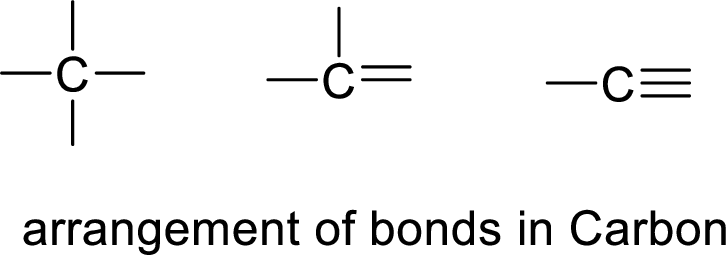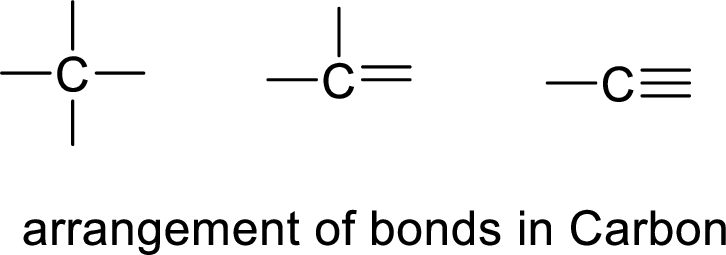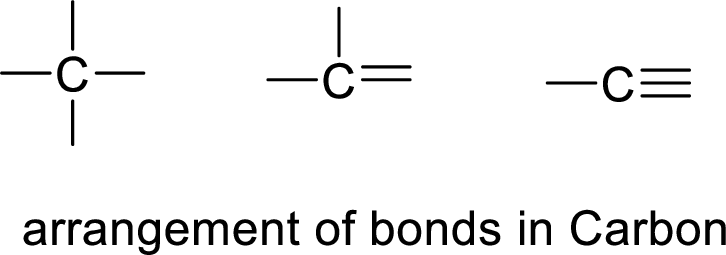
Concept explainers
(a)
Interpretation:
The correct number of hydrogens has to be added for the possible skeletons for a seven C compound with a six C chain and one double bond.
Concept Introduction:
The hydrocarbon is said to be a carbon atom bonded with hydrogen. The carbon atom contains four bonds. The bonds may be four single bonds or two single bonds and one double bond or one single bond and one double bond.

If the straight chain is branched, we get one type of hydrocarbon. If double bond is present, it restricts the rotation of the bond and forms cis and trans hydrocarbons.
(b)
Interpretation:
The correct number of hydrogens has to be added for the possible skeletons for a seven C compound with a five C chain and one double bond.
Concept Introduction:
The hydrocarbon is said to be a carbon atom bonded with hydrogen. The carbon atom contains four bonds. The bonds may be four single bonds or two single bonds and one double bond or one single bond and one double bond.

If the straight chain is branched, we get one type of hydrocarbon. If double bond is present, it restricts the rotation of the bond and forms cis and trans hydrocarbons.
(c)
Interpretation:
The correct number of hydrogens has to be added for the possible skeletons for a seven C compound with a five C ring and no double bonds.
Concept Introduction:
The hydrocarbon is said to be a carbon atom bonded with hydrogen. The carbon atom contains four bonds. The bonds may be four single bonds or two single bonds and one double bond or one single bond and one double bond.

If the straight chain is branched, we get one type of hydrocarbon. If double bond is present, it restricts the rotation of the bond and forms cis and trans hydrocarbons.
Want to see the full answer?
Check out a sample textbook solution
Chapter 15 Solutions
Chemistry: The Molecular Nature of Matter and Change
- What will the enolate for this be using LDA, THF, and cold temperatures? What will it be using NaOEt at rt?arrow_forwardHelp me solve this problem.arrow_forwardDraw a mechanism for the following synthetic transformation including reagents and any isolable intermediates throughout the process. Please clearly indicate bond cleavage/formation using curly arrows. MeO2Carrow_forward
- CHEM 310 Quiz 8 Organic Chemistry II Due: Tuesday, April 25th, at 11:59 pm. This quiz is open textbook / open notes - but you must work alone. You cannot use the internet or the solutions manual for the book. Scan in your work and record an explanation of your mechanism. You may record this any way that you like. One way would be to start an individual Zoom meeting, start recording, "share your screen" and then talk through the problem. This will be converted to an .mp4 file that you can upload into Canvas using the "record/upload media" feature. Pyridine, benzoic acid and benzene are dissolved in ethyl acetate. Design and provide a plan / flow chart for separating and isolating each of these components. Pyridine and benzene are liquids at room temperature. Benzoic acid is a solid. You have ethyl acetate, 2M NaOH, 2M HCI and anhydrous MgSO4 available, as well as all the glassware and equipment that you used in the organic lab this year. Provide accurate acid/base reactions for any…arrow_forwardCan anyone help me solve this step by step. Thank you in advaarrow_forwardPlease draw the mechanism for this Friedel-crafts acylation reaction using arrowsarrow_forward
 ChemistryChemistryISBN:9781305957404Author:Steven S. Zumdahl, Susan A. Zumdahl, Donald J. DeCostePublisher:Cengage Learning
ChemistryChemistryISBN:9781305957404Author:Steven S. Zumdahl, Susan A. Zumdahl, Donald J. DeCostePublisher:Cengage Learning ChemistryChemistryISBN:9781259911156Author:Raymond Chang Dr., Jason Overby ProfessorPublisher:McGraw-Hill Education
ChemistryChemistryISBN:9781259911156Author:Raymond Chang Dr., Jason Overby ProfessorPublisher:McGraw-Hill Education Principles of Instrumental AnalysisChemistryISBN:9781305577213Author:Douglas A. Skoog, F. James Holler, Stanley R. CrouchPublisher:Cengage Learning
Principles of Instrumental AnalysisChemistryISBN:9781305577213Author:Douglas A. Skoog, F. James Holler, Stanley R. CrouchPublisher:Cengage Learning Organic ChemistryChemistryISBN:9780078021558Author:Janice Gorzynski Smith Dr.Publisher:McGraw-Hill Education
Organic ChemistryChemistryISBN:9780078021558Author:Janice Gorzynski Smith Dr.Publisher:McGraw-Hill Education Chemistry: Principles and ReactionsChemistryISBN:9781305079373Author:William L. Masterton, Cecile N. HurleyPublisher:Cengage Learning
Chemistry: Principles and ReactionsChemistryISBN:9781305079373Author:William L. Masterton, Cecile N. HurleyPublisher:Cengage Learning Elementary Principles of Chemical Processes, Bind...ChemistryISBN:9781118431221Author:Richard M. Felder, Ronald W. Rousseau, Lisa G. BullardPublisher:WILEY
Elementary Principles of Chemical Processes, Bind...ChemistryISBN:9781118431221Author:Richard M. Felder, Ronald W. Rousseau, Lisa G. BullardPublisher:WILEY





